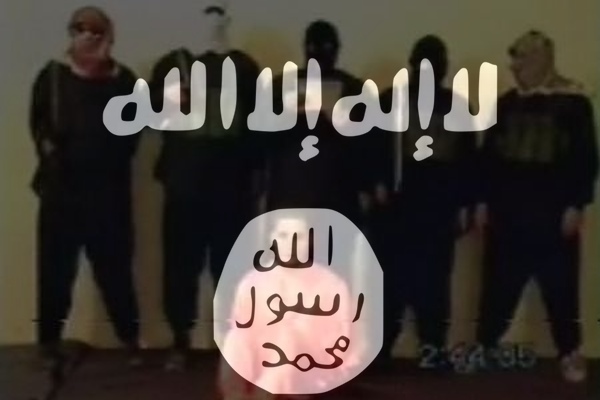The Rise of the ISIS Terrorist Army in Iraq and Syria: How Did we Get Here?

This June when an ISIS army of 7,000 Sunni fighters stormed north and conquered Mosul, Iraq’s second largest city, and much of northern Iraq, it appeared to many as if the terrorists had come out of the blue. But for those watching Iraq and Syria closely over the last few years it seemed almost destined to happen. In fact there were several steps taken by the Syrian, Iraqi and American governments that led to the rise of this terroristic Sunni Caliphate in the heart of what had once been two staunchly secular Socialist states in the Middle East.
The first and most crucial step in the creation of the ISIS Caliphate was the March-April 2003 US overthrow of the Sunni-dominated Baathist-Socialist regime in Iraq in the name of fighting Al Qaeda (which was actually shattered and in hiding in the remote tribal areas of Pakistan by this time) and hunting for Iraqi nuclear weapons programs and other chemical and biological WMDs (neither of which existed). This US invasion overthrew 500 years of Sunni dominance over the Shiites and disenfranchised Iraq’s ruling sectarian group. America achieved de-Sunification by disbanding the Sunni-dominated Iraqi Army and Baathist Party and essentially firing hundreds of thousands of Sunnis. When the previously repressed Shiites then took control of the police, army and government, they used their newfound power to oppress Sunnis.
Not surprisingly, the Sunnis responded to their disenfranchisement by launching a bloody insurgency against the Americans and the new Shiite-dominated government. Unfortunately, the disempowered Sunnis, who had been led by secular Baathist socialists for decades, turned to militant Islam to fight the US invaders. Many formerly secular Sunnis grew their beards long, rediscovered Islam and joined the newly formed Sunni group Al Qaeda in Iraq to wage jihad. President George Bush’s 2002 claim that there was Al Qaeda operating in secular Iraq had thus become a self-fulfilling prophecy and the 2003 invasion inadvertentlty “jihadified” tens of thousands of formerly secular Sunni Baathists by 2004.
The Sunni uprising was ultimately put down by US surge troops and the rise of the so-called Anbar Awakening (i.e. the creation of anti-Al Qaeda militias among Sunnis who had become disgruntled with the extremists’ reign of terror). On December 16, 2011, US troops withdrew from Iraq. It is crucial to note that the treaty to remove US troops from Iraq was signed in 2008 by President Bush and represented the will of the war weary US public whose country had lost 4,500 troops in Iraq and the democratically elected Iraqi government of President Maliki. As the US troops withdrew, Maliki, who was a Shiite, promised to treat the Sunnis fairly and include the Sunni Anbar militias in his military.
Unfortunately, Maliki proved to be more loyal to his Shiite followers and moved to arrest his Sunni Vice President and further weaken Sunnis, including the Anbar militias. When the Sunnis protested, Maliki used Shiite troops to suppress them. By the winter of 2014, the outraged Sunnis had risen up and taken control of Fallujah, a Sunni city that had been the former headquarters of Al Qaeda in Iraq and scene of two bloody US operations in 2004.
As all of these events were taking place in post-US Iraq, the so-called Arab Spring spread to Syria in 2011 and inspired Syrian Sunnis to rise up for greater rights against their country’s Shiite-Baathist rulers. When their protests were met with slaughter and brutality, the Syrian Sunnis fought back and formed the Al Qaeda-linked Nusra Front and the Islamic State in Iraq and Syria (ISIS). ISIS was seen as too brutal even by Al Qaeda which gave its brand name to the Nusra Front.
At this time, Senator John McCain called for the arming of weaker moderate Sunni rebels in Syria, including the Free Syrian Army, but President Obama resisted his efforts. Obama harkened back to the 1980s when the US armed mujahideen rebels in Afghanistan to fight the Soviets and some of them later turned against the US.
With no credible moderate opposition in Syria to fight the Syrian Shiite-government and its dreaded Shabiha death squads, thousands of Sunnis in Syria joined ISIS. By late 2013, ISIS, which had many former Al Qaeda in Iraq fighters in its ranks, had carved out a state in northern Syria based on the town of Raqqa. Then, in the winter of 2014, its fighters crossed the border and took control of the Sunni uprising in Fallujah.
The stage was set for ISIS to march on Mosul, a Sunni town, by June 2014. In June, ISIS raced north and routed Maliki’s Shiite army which did not have the will to defend this Sunni town. Had Maliki brought Sunnis (including the Anbar militias) into his army and government, they might have fought to protect Mosul from the militants as they had done during the Anbar Awakening in 2007. Instead, the repressed Sunnis joined ISIS whose numbers surged to over 31,000 after the conquest of Mosul according to the CIA.
Thus the Americans, Syrian Shiite government and Shiite-dominated Maliki in Iraq government inadvertently worked together to achieve what would have been unthinkable back in the spring of 2003 when Iraq was run by the Socialist ruler Saddam Hussein, namely the creation of a transnational Sunni jihadi Caliphate that rules an area the size of Maryland and 8 million people. It remains to be seen if the US can re-empower the Sunnis, many of whom have come to see ISIS as the primary means to right the injustices carried out against them by the Syrian Shiite government, Iraqi Shiite government and the U.S.